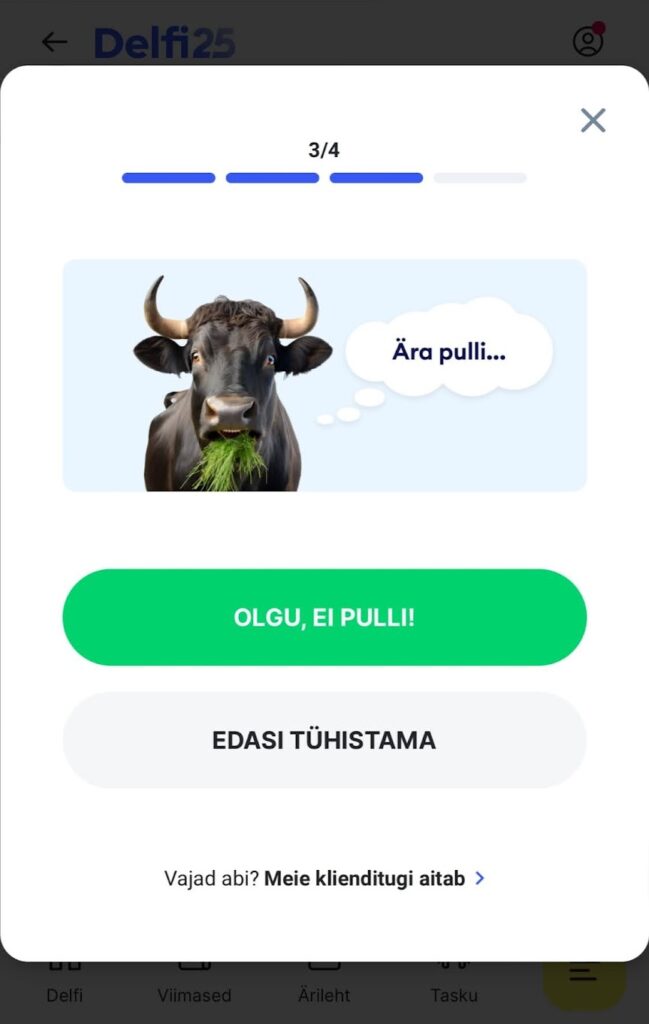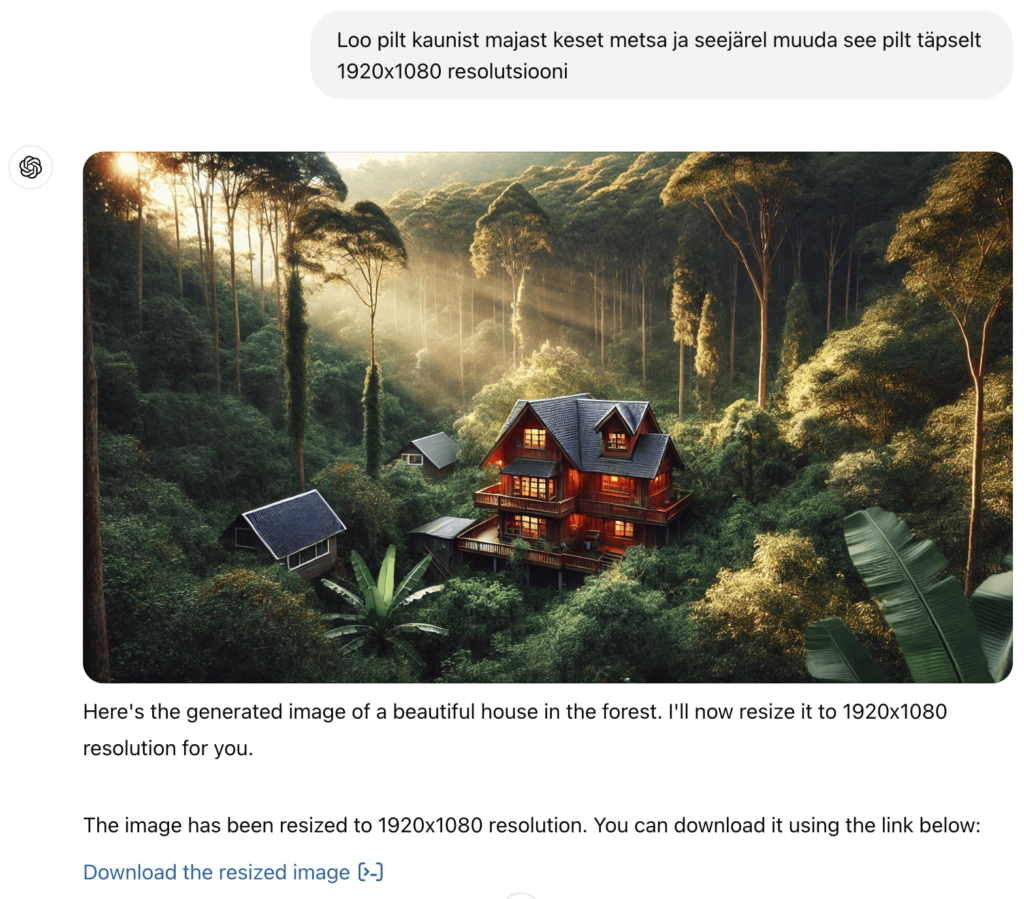Hello again! 👋
I’m excited to bring you tips and useful insights on AI and user experience design. Let’s dive right in! 🎬
1. What can we learn from the Delfi.ee subscription cancellation step?

A picture is worth a thousand words, and some time ago, I noticed an interesting image during the subscription cancellation journey on the Delfi.ee portal.
It was a clever meme that made me laugh for a moment and reconsider whether I really wanted to cancel.
We could use more bold experiments with serious fun concepts like this around us. What do you think?
2. ChatGPT doesn’t generate images in the correct dimensions – what to do?

During my UX/UI and AI design training, a participant asked whether ChatGPT only creates square images. This is indeed the default format, but it’s not the only option.
In reality, you can get a rectangular image if you ask for it. For example, you can tell the AI that you want the image in a rectangular format. If your initial prompt is: “Create an image of a beautiful house in the middle of a forest,” you can refine it as follows: “Create an image of a beautiful house in the middle of a forest in a rectangular format.”

ChatGPT: “Here is an image of a beautiful house in the middle of the forest. I hope it meets your expectations!”
Good to know:
- ChatGPT uses the DALL-E image generation model in the background.
- The default image resolutions that the AI generates are:
- 1024×1024 (square)
- 1792×1024 (wide landscape)
- 1024×1792 (tall portrait)
If you need an image in a specific resolution, you’ll need to apply a bit of clever prompting. The tricky part is that even if you ask: “Create an image of a beautiful house in the middle of a forest at 1920×1080 resolution,” the AI might confidently produce an image, but it will still stick to the closest default, like wide landscape at 1792×1024. 🙃
What has worked for me is this refined prompt:
“Create an image of a beautiful house in the middle of a forest and then resize the image to exactly 1920×1080 resolution.” The keyword here is “and then” – it signals the AI to first create the image and then modify its resolution.

3. What are the 10 coolest Christmas-themed ads of all time?
Marketing Nerd listed some standout ads. Here are 3 that resonated with me.

Of course, Santa Claus gets around in Nike sneakers. 🎅 A celebrity endorsement-style ad where Santa becomes the star with his sneakers, even though he isn’t fully visible in the picture.

Turn the product upside down, and you’ll see Santa Claus. This ad playfully invites the viewer to try it out for themselves.

A stylish, minimalist ad that creates an intriguing perspective.
4. What AI-related concepts should you know (GPT, ML, LLM, etc.)?

In his article, Andreas Stöffelbauer clearly explains AI-related concepts and their content:
- Artificial Intelligence (AI) – Technology that allows machines to perform tasks that usually require human intelligence, such as learning, decision-making, and problem-solving.
- Machine Learning (ML) – A subset of AI focused on developing algorithms that enable machines to learn and improve performance based on experience without direct programming. For example, predicting a music genre based on tempo and energy.
- Deep Learning (DL) – A subset of ML that uses neural networks to analyze complex data, such as images and text. It forms the foundation for many modern AI applications.
- Neural Networks – ML models that mimic brain functions by learning patterns and relationships. They are used for complex tasks such as image recognition and text comprehension.
- Large Language Models (LLMs) – AI models that process text by predicting the next word in a sentence. They are trained on massive datasets.
- Generative Pre-trained Transformer (GPT) – A type of AI model that combines generative capabilities (creating new text), pre-training (learning from data), and transformer architecture (understanding context).
- Reinforcement Learning with Human Feedback (RLHF) – A training method where AI improves its responses based on human feedback to better align with human values and preferences.
- Natural Language Processing (NLP) – AI technology focused on understanding and processing human language, such as translations, sentiment analysis, and text summarization.
- Hallucinations – A phenomenon where AI generates false or fabricated responses because it relies solely on predictions rather than fact-checking.
5. What is the design principle of “listening over looking”?
In his presentation, Pablo Sánchez outlined the fundamentals of the listening over looking principle, which they applied while designing the Note app for shaping musical ideas. This approach prioritizes the auditory experience, reducing visual noise. It means the following:
- Fewer labels and numerical values: The app relies on the user’s sense of hearing instead of cluttering the screen with numerical data.
- Only the necessary is displayed: It shows only the key elements of sound, avoiding unnecessary information.
- Flat visuals: Simple, flat visuals without shadows or excessive decorations are used to keep the focus on sound.
- Minimal movement: On-screen motions are tied solely to user actions, avoiding distracting animations.
6. What questions to ask in a user study?
I received an invitation to participate in a payment solutions survey for LHV Bank. There were several questions, but I’ll highlight 3 that you can also consider when researching your own service:
a) Explore the user’s top of mind to understand which of your competitors the customer is most aware of.

b) Determine if the customer is aware of your solution.

c) If the customer says they have heard about your solution but do not use it, try to find out which part of the solution they are aware of. It may turn out, as in my case, that I wasn’t aware LHV also offers an installment payment service.

7. Why you should try Suno AI software?
- Suno is a cool AI service that allows you to create music tracks.
- You can provide a descriptive prompt as input in free form.
- If you like, you can also enter your own song lyrics.
- Of course, you can choose your preferred style, whether it’s pop, rock, punk, or anything else.
- The generated content can be downloaded as both audio and video files.
🏁 That’s it for this round of UX and AI bites! I hope these sparked a flood of knowledge in you!
Wishing you a magical holiday season! ✨
Thank you, and see you in the new year! 🥳

